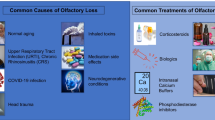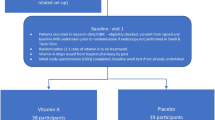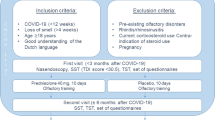Abstract
Vitamin A plays a decisive role in the regeneration of olfactory receptor neurons. In this retrospective study we investigated the effectiveness of topical vitamin A in patients with post-infectious and posttraumatic smell disorders. Retrospective cohort. A total of 170 patients (age range 18–70 years, mean age 52 years) participated. Forty-six patients were treated with smell training only. The remaining 124 patients received smell training and topical vitamin A. Olfactory function was assessed using the Sniffin’ Sticks test kit, a validated technique to measure odor thresholds, discrimination and identification. The duration of olfactory training was 12 weeks. In patients receiving vitamin A, this was applied topically (head back position) at a dose of 10,000 IU/day for 8 weeks. Follow-up testing was performed approximately 10 months after the first assessment. Thirty-seven per cent of all post-infectious patients treated with vitamin A exhibited clinical improvement, whereas only 23% improved in controls. Using a Chi-square test, this was a significant result (χ 2 = 7.06, df = 2, p = 0.03). In addition, when comparing change in score after treatment, olfactory training + vitamin A produced significantly greater improvement compared with training alone, in discrimination score for all patients (1.4 points, p = 0.008), and in threshold and discrimination in the post-infectious group (1.6 points, p = 0.01 and 1.4 points, p = 0.04, respectively). Intranasal vitamin A at a dose of 10,000 IU per day for 2 months may be useful in the treatment of post-infectious olfactory loss. Further work with prospective, placebo-controlled studies is required to confirm these findings.


Similar content being viewed by others
References
Vennemann MM, Hummel T, Berger K (2008) The association between smoking and smell and taste impairment in the general population. J Neurol 255(8):1121–1126
Murphy C, Schubert CR, Cruickshanks KJ, Klein BEK, Klein R, Nondahl DM (2002) Prevalence of olfactory impairment in older adults. JAMA 288(18):2307–2312
Croy I, Nordin S, Hummel T (2014) Olfactory disorders and quality of life-an updated review. Chem Senses 39(3):185–194
Philpott CM, Boak D (2014) The impact of olfactory disorders in the United kingdom. Chem Senses 39(8):711–718
Jafek BW, Murrow B, Michaels R, Restrepo D, Linschoten M (2002) Biopsies of human olfactory epithelium. Chem Senses 27(7):623–628
Korol DL, Brunjes PC (1992) Unilateral naris closure and vascular development in the rat olfactory bulb. Neuroscience 46(3):631–641
Gudziol V, Buschhüter D, Abolmaali N, Gerber J, Rombaux P, Hummel T (2009) Increasing olfactory bulb volume due to treatment of chronic rhinosinusitis-a longitudinal study. Brain 132(11):3096–3101
Schwob JE (2002) Neural regeneration and the peripheral olfactory system. Anat Rec 269(1):33–49
Brann JH, Firestein SJ (2014) A lifetime of neurogenesis in the olfactory system. Front Neurosci 8:1–11
Balmer JE, Blomhoff R (2002) Gene expression regulation by retinoic acid. J Lipid Res 43(11):1773–1808
Rawson NE, LaMantia AS (2007) A speculative essay on retinoic acid regulation of neural stem cells in the developing and aging olfactory system. Exp Gerontol 42(1–2):46–53
Duncan R, Briggs M (1962) Treatment of uncomplicated anosmia by vitamin A. Arch Otolaryngol 75:116–124
Reden J, Lill K, Zahnert T, Haehner A, Hummel T (2012) Olfactory function in patients with postinfectious and posttraumatic smell disorders before and after treatment with vitamin A: a double-blind, placebo-controlled, randomized clinical trial. Laryngoscope 122(9):1906–1909
Hummel T, Reden KRJ, Hähner A, Weidenbecher M, Hüttenbrink KB (2009) Effects of olfactory training in patients with olfactory loss. Laryngoscope 119(3):496–499
Haehner A, Tosch C, Wolz M et al (2013) Olfactory training in patients with Parkinson’s disease. PLoS One 8(4):1–7
Damm M, Pikart LK, Reimann H et al (2014) Olfactory training is helpful in postinfectious olfactory loss: a randomized, controlled, multicenter study. Laryngoscope 124(4):826–831
Hummel T, Sekinger B, Wolf SR, Pauli E, Kobal G, Hummel T (1997) 'Sniffin' Sticks’: olfactory performance assessed by the combined testing of odor identification, odor discrimination and olfactory threshold. Chem Senses 22(1):39–52
Hummel T, Kobal G, Gudziol H, Mackay-Sim A (2007) Normative data for the 'Sniffin’ Sticks' including tests of odor identification, odor discrimination, and olfactory thresholds: an upgrade based on a group of more than 3000 subjects. Eur Arch Oto-Rhino-Laryngology 264(3):237–243
Hedner M, Larsson M, Arnold N, Zucco GM, Hummel T (2010) Cognitive factors in odor detection, odor discrimination, and odor identification tasks. J Clin Exp Neuropsychol 32(10):1062–1067
Whitcroft KL, Cuevas M, Haehner A, Hummel T (2016) Patterns of olfactory impairment reflect underlying disease etiology. Laryngoscope 127(2):291–295
Gudziol V, Lötsch J, Hähner A, Zahnert T, Hummel T (2006) Clinical significance of results from olfactory testing. Laryngoscope 116(10):1858–1863
Benninger MS, Hadley JA, Osguthorpe JD et al (2004) Techniques of intranasal steroid use. Otolaryngol Head Neck Surg 130(1):5–24
Temmel AFP, Quint C, Schickinger-Fischer B, Klimek L, Stoller E, Hummel T (2002) Characteristics of olfactory disorders in relation to major causes of olfactory loss. Arch Otolaryngol Head Neck Surg 128(6):635–641
Deems D, Doty R, Settle R (1991) Smell and taste disorders, a study of 750 patients from the University of Pennsylvania Smell and Taste Center. Arch Otolaryngol Head Neck Surg 117(5):519–521
Murphy C, Doty RL, Duncan HJ (2003) Clinical disorders of olfaction. In: Doty RL (ed) Handbook of olfaction and gustation, 3rd edn. Marcel Dekker, New York, pp 461–478
Yamagishi M, Fujiwara M, Nakamura H (1994) Olfactory mucosal findings and clinical course in patients with olfactory disorders following upper respiratory viral infection. Rhinology 32(3):113–118
Anchan RM, Drake DP, Haines CF, Gerwe EA, LaMantia AS (1997) Disruption of local retinoid-mediated gene expression accompanies abnormal development in the mammalian olfactory pathway. J Comp Neurol 379(2):171–184
Zhang QY (1999) Retinoic acid biosynthetic activity and retinoid receptors in the olfactory mucosa of adult mice. Biochem Biophys Res Commun 256(2):346–351
Whitesides J, Hall M, Anchan R, LaMantia AS (1998) Retinoid signaling distinguishes a subpopulation of olfactory receptor neurons in the developing and adult mouse. J Comp Neurol 394(4):445–461
Asson-Batres MA, Zeng M-S, Savchenko V, Aderoju A, McKanna J (2003) Vitamin A deficiency leads to increased cell proliferation in olfactory epithelium of mature rats. J Neurobiol 54(4):539–554
Hagglund M (2006) Retinoic acid receptor-dependent survival of olfactory sensory neurons in postnatal and adult mice. J Neurosci 26(12):3281–3291
Yee KK, Rawson NE (2000) Retinoic acid enhances the rate of olfactory recovery after olfactory nerve transection. Dev Brain Res 124(1–2):129–132
Landis BN, Hummel T, Hugentobler M, Giger R, Lacroix JS (2003) Ratings of overall olfactory function. Chem Senses 28(8):691–694
Acknowledgements
We are indebted to Dr. Bettina Hauswald for her help with the clinical examination of the patients.
Author information
Authors and Affiliations
Corresponding author
Ethics declarations
Financial disclosure
Thomas Hummel was supported by a grant from the Deutsche Forschungsgemeinschaft (DFG HU441/18-1).
Conflict of interest
The author(s) declare that they have no competing interests.
Rights and permissions
About this article
Cite this article
Hummel, T., Whitcroft, K.L., Rueter, G. et al. Intranasal vitamin A is beneficial in post-infectious olfactory loss. Eur Arch Otorhinolaryngol 274, 2819–2825 (2017). https://doi.org/10.1007/s00405-017-4576-x
Received:
Accepted:
Published:
Issue Date:
DOI: https://doi.org/10.1007/s00405-017-4576-x




